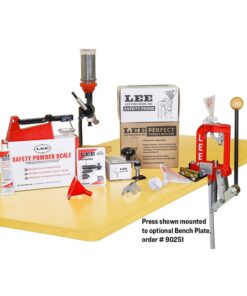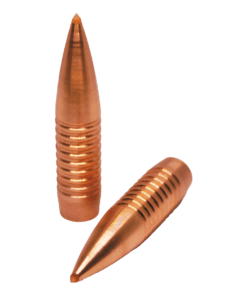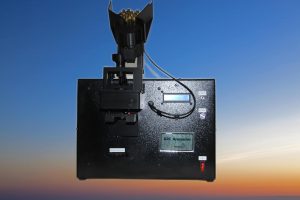Where Consistency is Key!
About ARC Precision Brass Annealers
At ARC Brass Annealers, we focus on transforming the brass annealing process. We aim to remove the guesswork and simplify it for everyone. By integrating advanced technology and reliable solutions, we ensure that users enjoy a seamless, efficient experience.
Our Vision: Precision and Control
Our mission at ARC Precision is to offer the most user-friendly brass annealing tools in the market. We believe precision and control are vital for reloaders to achieve excellent results. With our tools, they can extend brass life and improve reloading quality.
Innovative ARC Precision Technology for Every Reload
The ARC Precision Brass Annealer is designed with users in mind. Using the latest technology, we ensure every reload is precise and consistent. Our patent-pending Glow Sensor raises accuracy by automatically managing anneal temperatures. Additionally, the annealer offers three modes—Normal, Time, and Pulse—allowing reloaders to tailor their process for different case types.
Precision in Every Detail: Enhancing Heat Control
ARC Precision annealers include adjustable height settings, so users can apply heat precisely where needed. This helps prevent over-heating in unwanted areas of the brass. Whether you’re a beginner or experienced reloader, ARC’s heat control will guide you to the ideal annealing process.
Simplified User Experience: Easy Setup and Use
We have made sure the ARC Brass Annealer is easy to set up and use. Thanks to the Teflon Foot set, no expensive fixtures are required. You can begin annealing within minutes. Moreover, the pre-heat cycle and real-time data display offer reloaders complete control, ensuring the best results.
Cutting-Edge ARC Precision Features for Advanced Annealing
Our Mark 2 brass annealers boast several advanced features that enhance performance, including:
1000 memory slots: Save and instantly recall your programmed setups.
Active fan control: This feature prevents overheating and keeps your device running smoothly.
Multilingual interface: Available in four languages, making it accessible to users worldwide.
Why Choose ARC Precision : Join the Revolution
At ARC Brass Annealers, we constantly push the boundaries of innovation. We’ve crafted our annealers to offer unmatched performance, ease of use, and precision. From the patent-pending Glow Sensor to the 1000 memory slots, every feature is designed to enhance your annealing experience. So, why wait? Join the ARC revolution today and experience the future of brass annealing. With ARC Brass Annealers, you get the precision, consistency, and peace of mind that every reloader needs.
This is The Top of the Range Model.

ARC Standard Mark 2: Advanced Brass Annealer for Precision Reloading
The ARC Standard Mark 2 is a premium choice for advanced reloaders, packed with features designed to ensure precision, ease of use, and consistency. This world-class annealer is built for reloading enthusiasts across the globe, making it a standout product for your reloading setup. Let’s explore its key features and why it’s a must-have for serious reloaders.
Compact and Space-Saving Design
With a small footprint, the Standard Mark 2 is ideal for limited workspaces. Even with an optional feeder attached, it takes up minimal space on your reloading bench, offering powerful capabilities without crowding your work area.
Motorized Height Control
The motorized height adjustment allows for precise control over the annealing process. Each step moves approximately 0.4 mm, enabling users to fine-tune the height settings for optimal brass case annealing, ensuring consistent results every time.
User-Friendly Touch Screen Interface
Navigating through settings and configurations is seamless with the intuitive touch screen interface. This user-friendly design simplifies operation, allowing reloaders to quickly access their preferred settings and memory locations with ease.
1,000 Customizable Memory Slots
The ARC Standard Mark 2 offers 1,000 memory slots for storing your preferred annealing setups. You can assign custom names to each memory location, making it easy to organize and recall your most-used configurations. The current setting is clearly displayed on all screens to avoid any confusion.
Multilingual Support
Designed for a global audience, the ARC Standard Mark 2 supports multiple languages, including English, Afrikaans, Czech, and Slovak. As demand grows, additional languages will be included, ensuring usability for reloaders worldwide.
Multiple Annealing Modes
- Glow-Based Annealing: Tracks color variation for precise, high-quality results.
- Time-Based Annealing: Allows you to set specific annealing times for consistent, repeatable performance.
- Pulse Mode: Perfect for modern cases with steep thickness gradients, delivering fine-tuned control.
Future-Ready Connectivity
The ARC Standard Mark 2 is equipped with Bluetooth readiness for future enhancements and a USB-C port for easy firmware upgrades. This ensures your annealer remains up-to-date with the latest features and improvements. Please note that the USB-C port is strictly for firmware updates, not for charging other devices.
Advanced Cooling and Power System
The annealer’s 30mm fan ensures efficient cooling to prevent overheating and manage smoke, resulting in enhanced consistency. Operating primarily at 400W, it is built for long-lasting performance without overheating. The power supply is switchable between 115V and 240V AC, ensuring compatibility worldwide.
Statistical Tracking for Improved Results
The ARC Standard Mark 2 provides detailed statistics, displaying average, minimum, and maximum annealing times or glow values. This allows reloaders to refine their process for even better results. Additionally, it tracks the total number of anneals, giving insight into the device’s longevity.
Worldwide Shipping Available
We proudly offer worldwide shipping for the ARC Standard Mark 2. For a flat rate of $250 USD, customers around the globe can experience the precision and quality of this state-of-the-art brass annealer, making it the ideal choice for reloaders everywhere.
Global Bestseller for Reloaders
The ARC Standard Mark 2 is the ultimate reloading tool for precision and consistency, making it a flagship product on our website. Whether you’re an experienced reloader or looking to upgrade your setup, the Standard Mark 2 offers unparalleled performance, making it the go-to solution for global customers seeking top-tier results.
Order today and experience the next level of brass annealing.
For more details, visit our YouTube channel for in-depth product demonstrations.
This is a simple headline
Lorem ipsum dolor sit amet, consectetuer adipiscing elit, sed diam nonummy nibh euismod tincidunt ut laoreet dolore magna aliquam erat volutpat.
Induction Annealing
The Science and Benefits of Induction Annealing with ARC Precision
In the reloading community, the process of annealing brass is integral to ensuring the durability and performance of brass cases. Among the various annealing methods, induction annealing has emerged as a highly precise and effective technique. This article explores the intricate science behind induction annealing, compares it with traditional methods, and explains why it is crucial for reloaders.
1. Introduction to Induction Annealing
Annealing is a thermal treatment process used to alter the physical and chemical properties of a material, such as brass, to increase its ductility and reduce its hardness. This process is particularly important in reloading, where the performance and longevity of brass cases are paramount. Induction annealing, in particular, leverages advanced electromagnetic principles to achieve superior results.
2. The Science of Electromagnetic Induction
Electromagnetic induction is the process by which a changing magnetic field within a conductor induces an electric current in nearby conductors. This phenomenon, first discovered by Michael Faraday in 1831, is the cornerstone of induction annealing.
2.1 Alternating Current (AC) and Magnetic Fields
2.2 Electromagnetic Induction Principles
2.3 Applications of Electromagnetic Induction
Electromagnetic induction is foundational to many technologies:
- Transformers: Used to alter AC voltage levels.
- Generators: Convert mechanical energy into electrical energy through electromagnetic induction.
- Induction Cooktops: Utilize alternating magnetic fields to generate heat in conductive cookware.
- AC Motors: Convert electrical energy into mechanical motion using induction principles.
- Induction Annealers: Apply these principles to heat and anneal brass with high precision.
3. Induction Annealing in Detail
Induction annealing utilizes the principles of electromagnetic induction to heat brass cases in a controlled manner. The method provides several advantages over traditional annealing techniques.
3.1 The Process of Induction Annealing
-
Heating:
- An induction coil generates a high-frequency alternating magnetic field. When a brass case is placed inside this field, the magnetic flux induces an electric current (eddy currents) within the brass.
- The resistance of the brass to these eddy currents generates heat. As the brass heats up, its temperature rises uniformly.
-
Controlled Temperature:
- Induction annealers are designed to precisely control the temperature of the brass. This control is achieved through advanced temperature sensors and programmable settings, allowing for accurate and consistent annealing.
-
Annealing Modes:
- Normal Mode: Standard annealing based on time, ideal for uniform cases.
- Time Mode: Allows precise timing for each annealing cycle, ensuring consistent results.
- Pulse Mode: Designed for cases with steep thickness gradients or shorter cases, providing precise control.
-
Cooling and Safety:
- After annealing, brass cases are typically cooled either naturally or using forced air. Induction annealers often include cooling systems to prevent overheating and ensure safety.
3.2 Advantages of Induction Annealing
- Precision: Provides exact temperature control, leading to consistent results.
- Speed: Rapid heating compared to traditional methods, reducing cycle times.
- Consistency: Ensures uniform heating, reducing the risk of overheating or uneven annealing.
- Efficiency: Minimizes energy consumption and waste, leading to cost savings over time.
3.3 Comparison with Gas Annealing
-
Gas Annealing:
- Uses a flame or torch to heat brass cases. While cost-effective, it can result in inconsistent heating and requires careful monitoring.
- More prone to human error, leading to potential variations in annealing results.
-
Induction Annealing:
- Offers precise and repeatable heating, reducing the likelihood of inconsistencies.
- Provides faster and more efficient heating, ideal for high-volume reloading.
4. The Importance of Annealing in Reloading
Annealing brass cases is critical for maintaining their performance and extending their lifespan. Here’s why it’s essential:
4.1 The Role of Annealing
- Stress Relief: During firing and resizing, brass cases experience significant stress, which can lead to work hardening. Annealing relieves this stress, restoring the brass’s ductility.
- Preventing Cracks: Over time, work-hardened brass can develop cracks or splits, particularly in the case neck. Annealing prevents these issues by softening the brass.
- Extending Life: Properly annealed brass cases can be reused more times before needing replacement, offering better value and performance.
4.2 Materials Science of Cartridge Brass
- Composition: Cartridge brass is primarily made of copper and zinc. The exact ratio of these metals affects the brass’s mechanical properties.
- Mechanical Properties: Brass is measured for its strength and elasticity. The material’s response to force determines its yield strength and ductility.
4.3 Strength and Elasticity
- Elastic Deformation: Under stress, brass initially deforms elastically, meaning it returns to its original shape when the force is removed.
- Plastic Deformation: Beyond the yield point, brass undergoes plastic deformation, resulting in permanent changes. The yield strength is the force required to reach this point.
4.4 The Benefits of Annealing
- Consistency: Annealing ensures that all brass cases are uniformly softened, leading to consistent performance.
- Reduced Failures: By softening the brass, annealing minimizes the risk of case failures or splits during reloading and firing.
5. The ARC Standard Mark 2 Annealer
The ARC Standard Mark 2 is an advanced induction annealer designed for precision and ease of use. Here’s a comprehensive look at its features:
5.1 Key Features
- Memory Slots: Equipped with 1000 memory slots, allowing users to store and recall different annealing setups.
- Multi-Language Support: Available in English, Afrikaans, Czech, and Slovakian, with plans to add more languages.
- Touch Screen Interface: User-friendly interface for easy navigation and configuration.
- Active Fan Control: Dynamically adjusts fan speed based on temperature changes to ensure consistent heating.
- Motorized Height Adjustment: Provides precise control over the height during the annealing process.
- Annealing Modes: Offers Normal, Time, and Pulse modes to cater to various case types and thickness gradients.
- USB-C Port: Facilitates firmware upgrades for future enhancements.
- Bluetooth Readiness: Prepares the annealer for future connectivity and upgrades.
- Cooling Fan: Includes a small 30mm fan to manage smoke and enhance consistency.
5.2 Additional Specifications
- Compact Footprint: Designed to fit into limited workspaces while maintaining powerful performance.
- Motorized Height Control: Allows precise adjustments with steps roughly corresponding to 0.4 mm.
- User-Friendly Touch Screen GUI: Intuitive interface for easy access to settings and memory locations.
- Custom Memory Names: Enhances organization with custom names for each memory slot.
- Cooling and Power: Operates efficiently with an air-cooled design and adjustable AC power supply (115 or 240V).
5.3 Statistical Insights
- Time and Glow Values: Displays average, minimum, and maximum time or glow values for statistical analysis.
- Total Neals Displayed: Tracks the total number of annealing cycles over the instrument’s lifespan.
5.4 Delivery and Shipping
- Delivery Time: If not in stock, expect delivery within 3 to 4 weeks.
- Worldwide Shipping: Available at a cost of $250 USD.
6. Conclusion
Induction annealing, exemplified by the ARC Standard Mark 2, represents a significant advancement in the reloading process. By harnessing the principles of electromagnetic induction, ARC Precision offers a solution that delivers unparalleled precision, consistency, and efficiency. This method not only enhances the performance of brass cases but also extends their lifespan, making it a vital tool for reloaders who seek the best results.
Embrace the power of induction annealing with the ARC Standard Mark 2 to elevate your reloading experience. For more information and detailed demonstrations, visit our YouTube channel and explore the full capabilities of this cutting-edge annealer.
7. References and Further Reading
For those interested in delving deeper into the science and technology behind induction annealing, consider the following resources:
- Faraday’s Law of Induction: [Link to educational resources]
- Electromagnetic Induction in Modern Technology: [Link to technical papers and articles]
- Cartridge Brass Materials Science: [Link to materials science journals and textbooks]
This comprehensive exploration of induction annealing with ARC Precision aims to provide a thorough understanding of the process, its benefits, and its application in the reloading community.
 Veldt SHOTBLAST TRIGGER AND MECHANISM CLEANER 400ml
1 × R 126.00
Veldt SHOTBLAST TRIGGER AND MECHANISM CLEANER 400ml
1 × R 126.00 FRANKFORD ULTRASONIC BRASS CLEANING SOLUTION 32OZ
1 × R 645.00
FRANKFORD ULTRASONIC BRASS CLEANING SOLUTION 32OZ
1 × R 645.00 Veldt Co-G Multi-purpose Oil 10ml
1 × R 125.00
Veldt Co-G Multi-purpose Oil 10ml
1 × R 125.00 Veldt RIMFIRE Bore Cleaner 60ml
1 × R 87.00
Veldt RIMFIRE Bore Cleaner 60ml
1 × R 87.00 Veldt RIFLE BUTTER XTREME 10ml
1 × R 99.00
Veldt RIFLE BUTTER XTREME 10ml
1 × R 99.00 Veldt Veldt CASE BLEND Casing Cleaner 500ml
1 × R 142.00
Veldt Veldt CASE BLEND Casing Cleaner 500ml
1 × R 142.00 Veldt RESIZING CASE WAX 30ml
1 × R 135.00
Veldt RESIZING CASE WAX 30ml
1 × R 135.00 LEE 50th Anniversary Breech Lock Challenger Kit - Comprehensive Reloading Set for Beginner and Experienced Reloaders
1 × R 4,560.00
LEE 50th Anniversary Breech Lock Challenger Kit - Comprehensive Reloading Set for Beginner and Experienced Reloaders
1 × R 4,560.00 Q-8 SILICON SPRAY 150ML
1 × R 90.00
Q-8 SILICON SPRAY 150ML
1 × R 90.00 Q-GUN SPRAY 400ML
1 × R 179.00
Q-GUN SPRAY 400ML
1 × R 179.00 AXE 9.3mm Bullets
1 × R 700.00
AXE 9.3mm Bullets
1 × R 700.00 AXE .223 / .224 55GR Bullets
1 × R 720.00
AXE .223 / .224 55GR Bullets
1 × R 720.00 AXE .303 / .311 Bullets
1 × R 895.00
AXE .303 / .311 Bullets
1 × R 895.00 Balistix Pro Annealer (GAS)
1 × R 3,632.00
Balistix Pro Annealer (GAS)
1 × R 3,632.00 AXE .323 / 8mm Mauser Bullets
2 × R 1,160.00
AXE .323 / 8mm Mauser Bullets
2 × R 1,160.00



